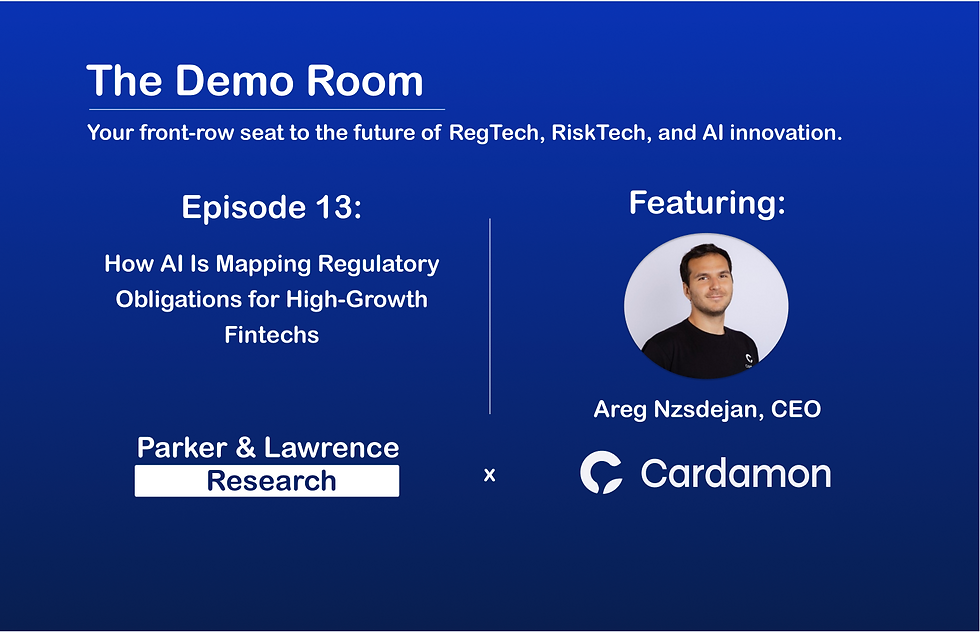Automating ESG Reporting & Disclosures with Generative AI (The Demo Room #3)
- Michael Lawrence

- Aug 15, 2024
- 3 min read
Updated: Apr 10
Welcome to The Demo Room – your front-row seat to the future of RegTech, RiskTech, and AI innovation.
In this series, we document our research interviews with the most forward-thinking vendors tackling the industry's biggest challenges. Each blog is built around a comprehensive product demo, providing clear insights into how these innovations address industry challenges.
On this occasion, we spoke to Carla Nassisi, Product Manager at Briink Castlepoint.
In their 2024 research report, Generative AI in Risk and Compliance: Friend or Foe?, Parker & Lawrence examine the impacts and risks of emerging AI capabilities across 14 RegTech use cases, with insights from 17 expert contributors.
Among those use cases is ESG reporting & disclosures:
What Are ESG Reporting & Disclosures Tools?
ESG Reporting & Disclosure tools support the automation of non-financial, sustainability and environmental, social and governance reports. The focus of these tools can range from the reports themselves, automating their creation by retrieving and inputting data points into ready-made templates, to the policies and regulations that govern reporting, automating the review of comparison of internal and external rules.
Key Generative AI Use Cases in ESG Reporting & Disclosures
Expert contributors helped map the opportunities, risks and imminence of 400+ Generative AI applications. The mapping of ESG Reporting & Disclosures opportunities shows 5 impactful Generative AI capabilities:
Comparing Documents: The capacity of Generative AI to analyse and highlight differences or similarities between various documents, aiding in tasks such as version control, plagiarism detection, and legal document analysis.
Creating Reports: The use of Generative AI to create detailed, structured reports based on input data. This includes comprehending the potentially formal and official nature of regulatory reporting.
Editing Reports: Generative AI’s ability to identify errors, refine, correct and otherwise improve reports. This usually involves mapping reports to the policies or regulations which necessitate them, and the input data which inform them, for maximum context.
Client Interactions: The deployment of generative AI in interactive applications such as chatbots or guided workflow tools to simulate human-like conversations, providing support to end-customers.
Internal Co-pilot: Leveraging Generative AI to assist in investigative tasks by generating hypotheses, suggesting lines of inquiry, and synthesising findings from diverse data sources to support human investigators.
Of which four have already seen Generative AI implemented or will do imminently.
Impact vs Readiness
Want to dive deeper? Check out the full report for expert commentary:
The Industry's Perspective
Throughout the research, experts from technology vendors, regulated institutions and regulators share new insights on Generative AI in risk and compliance. Thank you to Briink for contributing an industry perspective on Generative AI in ESG Reporting & Disclosures.
To keep this blog bitesize, here is just one excerpt inspired by Briink's insights:
The Generative AI Opportunity in ESG Reporting & Disclosures
Briink has used a combination of GPT, Llama and their proprietary ESG dataset to produce an ESG-specialised AI assistant. Among many other use cases, the model supports institutions and ESG auditors to verify the accuracy of ESG disclosures and, for institutions, to ensure that their information is sufficient for their reporting requirements.
Ordinarily, retrieving this information would place a high time burden on analysts who would review hundreds of pages of documentation or, with ESG questionnaires, would put a dependency on third parties to; answer the questions, to be accurate and to do so in a timely manner.
Briink’s templates align questions to relevant regulations such as the Corporate Sustainability Reporting Directive (CSRD) or the Sustainable Finance Disclosure Regulation (SFDR), or allows users to create their own questions. Briink’s AI can then answer these questions itself, by researching relevant websites and documents. This functionality works well as pre-screening for third parties, or post, in verifying the truth of third parties’ self-reported data.

Briink is creating the AI infrastructure which empowers sustainability and ESG analysts with the tools they need to gather data faster, and generate essential insights. Their ESG-specialised AI assistant already supports analysts and auditors with questionnaires, data gathering and assurance.
About Parker & Lawrence
At Parker & Lawrence, we are passionate researchers with extensive experience in regulation, risk, and technology. Our unique blend of market analysis and collaboration with regulators, technology vendors and their buyers positions us at the forefront of industry insights. We specialise in AI, RiskTech and RegTech, forming dynamic partnerships with clients to elevate their marketing strategies.
Get involved
Are you ready to become a thought leader? Reach out to discuss our ongoing research initiatives, how they impact your firm and where we can work together to position you at the forefront of your industry.




